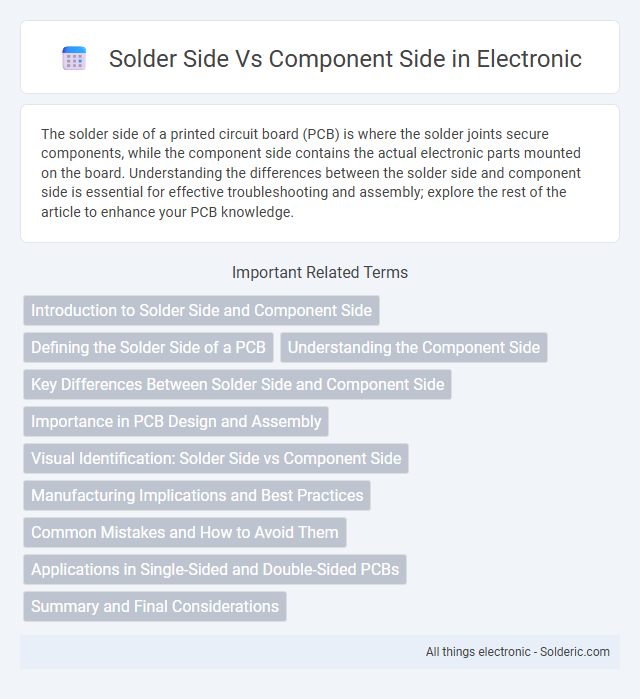The solder side of a printed circuit board (PCB) is where the solder joints secure components, while the component side contains the actual electronic parts mounted on the board. Understanding the differences between the solder side and component side is essential for effective troubleshooting and assembly; explore the rest of the article to enhance your PCB knowledge.
Comparison Table
| Aspect | Solder Side | Component Side |
|---|---|---|
| Definition | PCB side where solder joints are made | PCB side where components are mounted |
| Primary Function | Secures electrical connections by soldering | Houses electronic components |
| Component Presence | No components, only solder pads and traces | Contains resistors, capacitors, ICs, etc. |
| Visibility During Assembly | Visible solder joints and pads | Visible components and their orientation |
| Inspection Focus | Solder joint integrity, cold joints, bridges | Component placement, polarity, and labeling |
| Typical Use | Soldering and rework operations | Component mounting and testing |
| Location | Opposite side of components on PCB | Top or primary side of PCB |
Introduction to Solder Side and Component Side
The solder side of a printed circuit board (PCB) refers to the side where electronic components are soldered, featuring visible solder joints and pads. The component side houses the electronic components themselves, including resistors, capacitors, and integrated circuits, mounted on the PCB surface. Understanding the distinction between solder side and component side is critical for accurate PCB assembly, testing, and repair.
Defining the Solder Side of a PCB
The solder side of a PCB, also known as the solder side layer, is the side where electronic components are soldered to the circuit board, featuring solder pads and traces for electrical connections. This side typically shows visible solder joints connecting component leads or surface-mount devices (SMDs) to copper pads, ensuring mechanical stability and electrical conductivity. Understanding the solder side is crucial for effective PCB assembly, inspection, and rework processes, distinguishing it from the component side where the actual components are mounted.
Understanding the Component Side
The component side of a PCB houses all electronic components such as resistors, capacitors, and ICs, which are mounted and soldered onto the board. Understanding the component side is crucial for proper assembly and troubleshooting, as it directly affects circuit functionality and performance. Your ability to identify and interpret markings and placements on the component side ensures accurate repairs and efficient design modifications.
Key Differences Between Solder Side and Component Side
The solder side of a printed circuit board (PCB) primarily features solder joints connecting electronic components, while the component side houses the actual components like resistors, capacitors, and integrated circuits. The solder side often has exposed copper pads and traces optimized for solder adhesion, whereas the component side includes silkscreen labels and physical component placements for assembly and inspection. Understanding these distinctions is critical for PCB assembly, troubleshooting, and repair to ensure proper electrical connections and component placement accuracy.
Importance in PCB Design and Assembly
Solder side and component side distinction in PCB design is crucial for accurate assembly and solder joint reliability, ensuring components are correctly oriented and soldered. Proper identification of solder side minimizes defects like solder bridges and cold joints, enhancing overall circuit performance. Efficient assembly processes depend on clear separation between these sides to streamline automated placement and inspection.
Visual Identification: Solder Side vs Component Side
The solder side of a printed circuit board (PCB) is easily identified by its array of exposed solder joints, where electronic components are electrically connected. In contrast, the component side displays the electronic parts themselves, including resistors, capacitors, and integrated circuits, mounted on the board's surface. When inspecting your PCB, recognizing these visual differences helps ensure accurate assembly and troubleshooting.
Manufacturing Implications and Best Practices
Solder side and component side placement significantly impact PCB manufacturing processes, affecting assembly accuracy and rework efficiency. Automated Optical Inspection (AOI) and solder paste application require precise alignment and optimal stencil design tailored to each side for defect reduction. Best practices emphasize clear documentation, controlled thermal profiles, and strategic component orientation to enhance solder joint reliability and streamline mass production workflows.
Common Mistakes and How to Avoid Them
Common mistakes when working with the solder side versus the component side of a printed circuit board (PCB) include misidentifying component orientation and applying solder incorrectly, which can result in poor electrical connections or damage. To avoid these issues, always verify component placement against the PCB layout diagram before soldering and use proper soldering techniques such as controlled solder flow and adequate heating time. Inspecting joints on the solder side for cold solder or bridges ensures reliable connectivity and reduces the risk of circuit failure.
Applications in Single-Sided and Double-Sided PCBs
The solder side of a PCB primarily accommodates solder joints and connections, ensuring electrical continuity, while the component side houses the electronic components and their footprints. In single-sided PCBs, components and solder pads are placed on opposite sides, making the solder side crucial for establishing connections, whereas double-sided PCBs utilize both sides for component placement and soldering, allowing for higher circuit density and more complex designs. This dual-surface approach in double-sided PCBs enhances performance in applications requiring compactness and multifaceted circuitry, such as in advanced consumer electronics and industrial controls.
Summary and Final Considerations
The solder side and component side of a printed circuit board (PCB) serve distinct but complementary purposes in electronic assembly and repair. The solder side, typically the underside, is where solder joints connect electronic components to the PCB, ensuring electrical conductivity and mechanical stability. When working with your device, understanding the differences between these sides helps in accurate troubleshooting and efficient soldering, ultimately enhancing the durability and performance of your electronic projects.
Solder side vs component side Infographic

 solderic.com
solderic.com